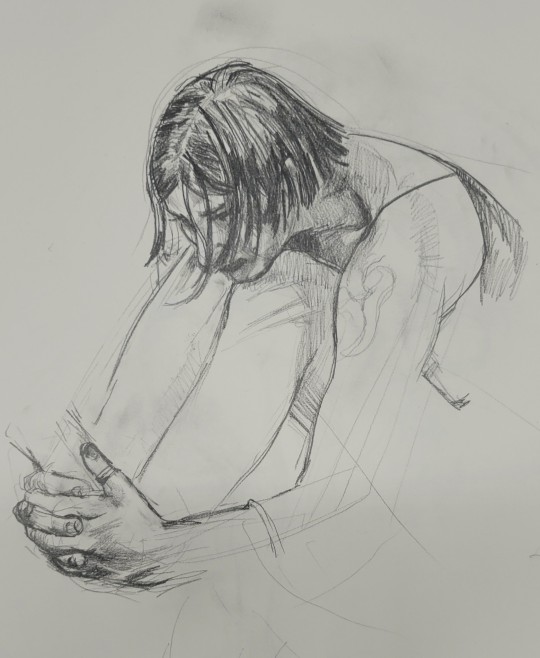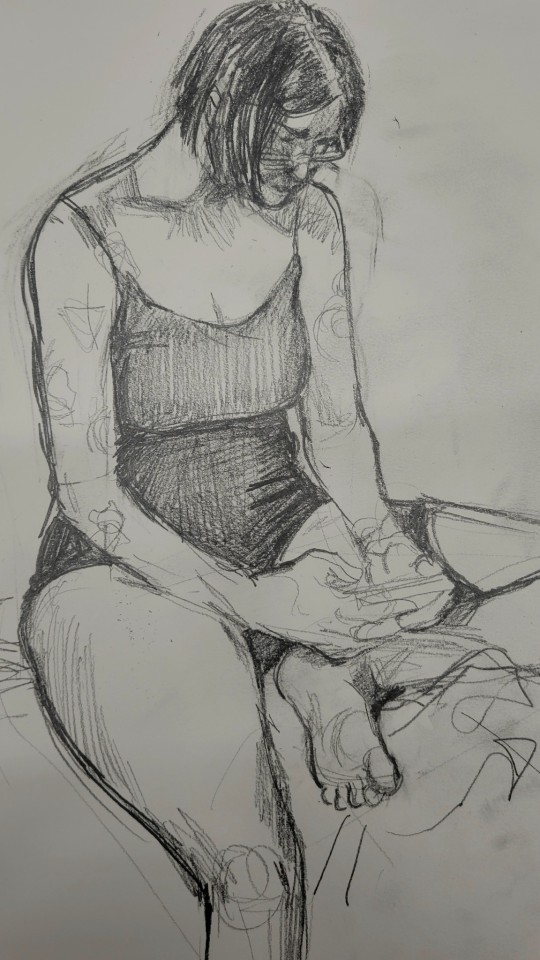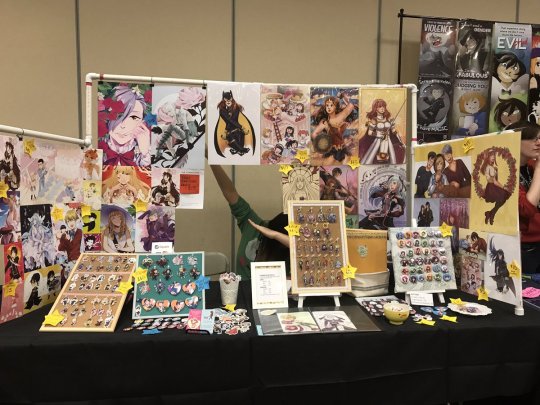#the actual drawing is a lot bigger than they look i drew on 11x17 i believe
Explore tagged Tumblr posts
Text


Not my usual post but i havent been to a figure drawing class since Nov and i finally got to go back today woohoo!
#i was kinda rusty but these two were the 30 min ones and i like how they turned out#i was also a little late so i missed some poses#figure drawing#life drawing#mschismosa#the actual drawing is a lot bigger than they look i drew on 11x17 i believe#which is a big change i usually draw so small lol#we r getting used to new things
9 notes
·
View notes
Text
Top 10 Things I Learned From Artist Alleys
Hi guys! I thought I’d write a post on some things I’ve learned from selling my own art at artist alleys over the years & talking to fellow artists, as it’s something I’ve wanted to discuss and thought people would be interested. This isn’t really an Artist Alley 101 guide, as I wrote this in mind for both for beginners and veterans, because even if you’ve been tabling for years, there are things about the artist alley scene that can keep changing, or things you never knew about. Hope this helps!
LONG POST IS LONG WARNING

10. Bigger doesn’t always mean better – people keep thinking this, but it’s not always true.
Smaller conventions are easier to talk to attendees/artists because there’s often slow periods, and are good if if they’re local and you need a place to start. You can also get away with having only a few things to sell and if it doesn’t go well it won’t be a huge loss. Smaller cons tend to also have a lower table cost, and because the artist alley is smaller, it’s easier to “stand out”. Probably because of this, I’ve heard some cases where some people have made the same amount of profits from certain small cons vs. big cons, meaning, they actually got more sales per person at the smaller con.
Bigger conventions CAN command big bucks and keep you busier with sales because there’s more attendees and potentially more money to go around. However, they are also more competitive: if all you have is ONE print when everyone else around you has huge displays, you risk people passing by you because they may think you don’t have anything of interest to offer. As an example, maybe at the small con, your Overwatch solo D.Va print was the only one there and it did well, but at a big con, 20 other artists could also have similar D.Va prints and are now competing with each other, which is something you should consider.
Every con is different so when researching, you want to take into consideration the ratio of artist/vendor tables available in conjunction to attendee count, events/guests, and the con environment.
With both cons, if you frequent the same ones, try to keep things fresh and make new stuff or else you risk oversaturating your market and having people come up to your table thinking “I’ve seen that same poster 3 years already, and I already have it. What’s new?”
9. Just because something is popular doesn’t necessarily mean it’ll sell right away – there’s a fine line between “it’s popular so fans will buy it” and “it’s popular but it’s oversaturated because everyone and their mom drew it and it won’t sell unless you differentiate your work from everyone else”. I’d argue if you’re passionate about a series and it just happens to be popular, go for it! You should draw what you like, because it’ll show in how you interact with other fans and the effort you put into it.
If you’re only drawing for the popularity, well, there’s a bit of debate about this. And let’s be honest, some of us need to pay bills. I’ll argue if you ONLY draw whatever is popular to sell out, it can reflect in the quality of your work and make you unmemorable (and you can still risk it not selling), but hey, you do you. But drawing only niche things may also be tricky, since the fans are probably very passionate, but few in number. Sometimes finding a balance between both can work, but at the end of the day, it’s up to you to decide what path you want to take. Most artists start out doing fanart as it’s easier for someone to walk up to your table if they recognize their favorite character than a table full of random OCs standing in a backgroundless void. But that’s not to say originals can’t sell because....
8. Originals sell! Don’t be afraid to make original content – this might shock some of you but original merchandise DOES sell, according to many successful anecdotal stories from artists and art friends who’ve done it, and a lot of people have said it is very rewarding, especially when you consider how prevalent fanart is. However, originals can be harder to sell – it will highly depend on the subject matter you’re drawing and attendees at certain cons may be more or less receptive to them than others, so you may have to try different cons to find your market. What has worked for others may not work for you. You might even need time to develop a consistency with your work so people know what to expect from you.
There are also a few conventions out there, such as Otakon, which do require you to have a certain % of originals when you apply for their artist alley, so there’s that.
7. Have stuff with different price points at your table – my personal opinion is “Do not do print-only tables” but I know there are artists out there who DO command good profits only selling prints and posters of their artwork.
But why I say this is because (especially at anime cons) there are usually younger kids who don’t have much disposable income or don’t have a lot of wall space and thus, can’t always afford big $20 posters, which is where having smaller items like charms and buttons can help as impulse purchases. It may take you 10 purchases of $2 buttons to reach that equivalent amount, but if you do get enough sales they’ll add up. Plus, it’s easier for some people to make use of charms and buttons.
Prints are still good because the profit margin is better and they're a way for your audience to see your "portfolio" and art style from afar. At larger cons where there’s a sea of artists, having many prints can help others see what you have or help find your table from a distance. Try and stick to common print sizes such as 11x17 inches, 8.5x11, 4x6 or 5x7, mostly on the basis that they’re easier to frame.
One thing - unless you plan on traveling to many conventions in your life, you do NOT need to print 50+ copies of each print if all you do is table at your small local con once a year. You will regret it and be stuck with them until you die (I’m not kidding). Unless a piece has proven to you it’s a best seller, I recommend printing 5-10 copies a print, 2-4 if you aren’t confident. You can always reprint more if they sell well, or replace them with newer prints.
Comic cons I hear are a little different, as their audience is usually older, but I can’t say much about them since I never actually vended at one before.
6. You gotta spend money to make money – You wanna make cool stuff like charms, lanyards, enamel pins? A button maker to make your own buttons? A dealer’s room spot instead of a regular artist alley table? Travel to cons outside your city? Heck, just buying table display stuff and getting new prints? That all costs money, bruh. This might require you save up, and some people I know even use their day job to help fund them to afford nice things. But artist alley IS also a business, and if you want your business to grow, you’ll need to take risks and invest in it. However, know that this should happen gradually over time and NOT overnight. If you literally have no previous experience selling your art and knowing what worked for you, do NOT carelessly throw down money to make every fancy merchandise imaginable.
5. Talk to people and engage with attendees! I say this because I’ve seen quite a few artists who are great at their craft, but aren’t good at business at all. Even if you aren’t confident about your work, still strive to be as professional as possible. And be your own cheerleader/salesman to your art! If the con is slow, don’t ignore customer’s questions by playing mobile games on your phone. People get energy off of you, and if you happen to seem like you hate people, attendees pick up on that. A lot of people who go to anime cons can be introverted/shy as well, so just saying hi and ask how they’re enjoying the con is a good start to engage with them! If you notice they’re cosplaying a character, tell them you like their cosplay or happen to have that character as a button! You’d be surprised some people may not know you offer a product because they overlooked it.
I usually let customers browse the table without bothering them, as people get uncomfortable if you’re being too desperate with sales.
4. Displays and Table Placement matter- Your table placement at a convention can dictate a HUGE majority of your sales, and how you display yourself also counts as well. You could have amazing art, but maybe your table is in some back corner where it’s not getting enough foot traffic compared to the people in the front. Additionally, if you have merchandise hidden behind other merch, other people can’t see it as they walk by. Presentation is important, there are so many possibilities you can do to make your table look nice.
The most common way people display their prints are usually either by using grid cubes, photography stands or PVC pipes with clamps. All of these have their pros and cons, and some artists even use a combination of the 3.
3. Cons are extremely volatile. Artist alley is NOT a place to “get rich quick” – To be blunt (and unfortunately, speaking from personal experience), you can’t predict when you’ll get dicked over by a badly-run con. No two cons are the same, and the same convention can even vary from year to year, depending on things like how it was run by staff, its location, when it was held, etc. At one con, you may sell out of prints. At another, only your commissions do well. Even something as simple as a venue change and increasing the amount of artist/vendor tables can affect sales. You can only prepare as much as you can and hope you survive the rainy days.
I used to think as you got older and sold at more artist alleys, your profits could only go up and boy was I wrong with that notion. The realest piece of advice I’ve learned is seeing seasoned veterans (who are used to making 4-digit profits or artists who have done this for over 7 years) having times where they hit a bad con and don’t even break even. If you’ve never had a terrible con before, you are either very lucky or you have not vended at enough different cons to experience this.
A lot of different factors can come into play, and while some you can’t control, think of the ones that you can – was your setup bad? What do you see other attendees buying? Or maybe was this your first con in a completely different area and it caught you off guard? If you feel your art was lacking, don’t lose confidence. Look at it as an opportunity to find yourself again, and work hard on your craft so you can show everyone at your next event “hey, this is the new and improved me! Look at how far I’ve come!”
2. Artist alleys can be stressful and are getting more competitive, but it’s important to develop a thick skin to keep moving on – I should clarify this, AA should NOT be a sea of cutthroat competition because every con has its mix of those starting out, the veterans who have been doing this for 10 years, and everyone else in between. And everyone has something different to bring to the table. However, the fact is… artist alleys are getting competitive each year just to GET IN. At some popular cons, there’s always more applicants than tables available, and you can’t take it personally when 1,000+ people are in a lottery for 90 tables.
As artists, we are always our worst critics as well, just because art can be highly personable to us. There’s a lot of things that can go wrong in the moment. Maybe you got more commissions than you can handle. Your new merchandise didn’t arrive on time. Or you worry your art isn’t “sellable”. All of these can be pretty frustrating and question your self-worth as an artist. But just know you are not alone, all of us have had those moments at least once, maybe even multiple times in our lives. Sometimes you just have to keep marching on, despite things. And if you need time to step away to take a breather, go ahead and take care of yourself first.
1. … But you keep wanting to do them because they are also one of the best experiences you can have as a creative – despite the above, artist alleys have been an integral part of my growth as an artist. Seeing what everyone has to offer has challenged me to keep improving my art and helped me meet fellow artist friends thru our comradery of shared experiences, interests, and stresses. It’s very easy to feel dejected, but if you can keep pushing thru, you’ll probably benefit the most than those who give up at the slightest hint of being butthurt. The artist alley life isn’t exactly easily, but it’s heartwarming when you have moments where “doing what you love” and “drawing what you like” feel like it paid off.
Don’t feel bad if your first shows don’t go logistically or financially great! I never realized how lucky I was that my first AA, I broke even AND made profit, because many apparently don’t. Go into it as an opportunity to market your work, meet other artists and customers, and figure out what people like about your art. Artist alley is not for everyone, but if you find that you’re growing to love it despite the hiccups, keep going! My AA experience isn’t as extensive as others, but I hope with this, this is my way of giving back to the artist alley community that helped me grow as an artist.
If you’re still worried if you’re “good enough” to do artist alley, here’s my final advice: just do it, bruh.
#artist alley#artist alley tips#first time artist alley#how to be a con artist#if you read this far THANK U AND I HOPE THIS HELPED. and feel free to send me an ask or message if you have any questions!1
1K notes
·
View notes